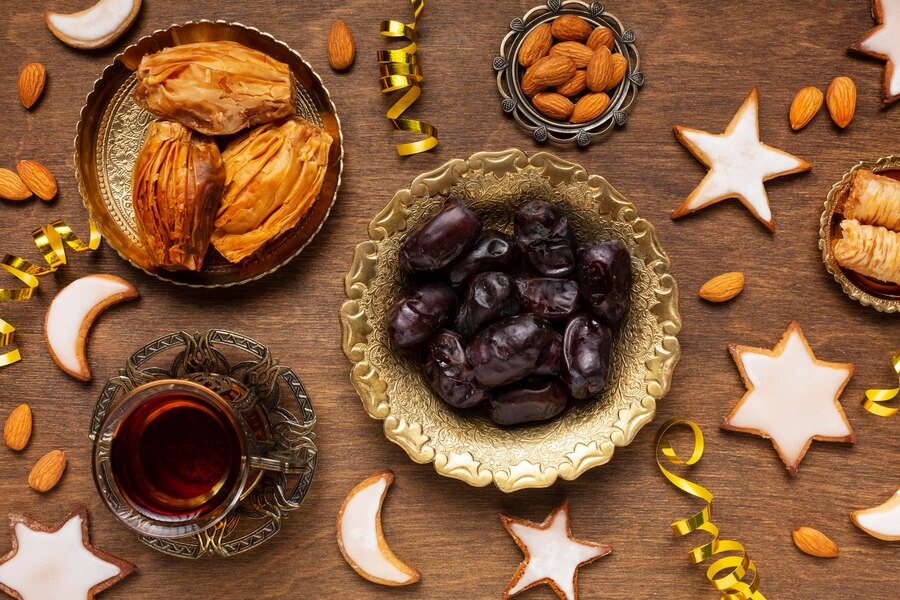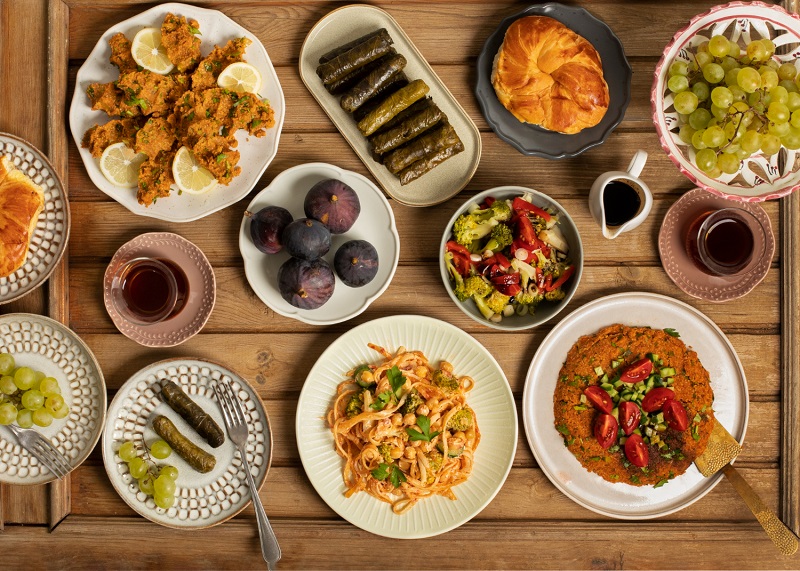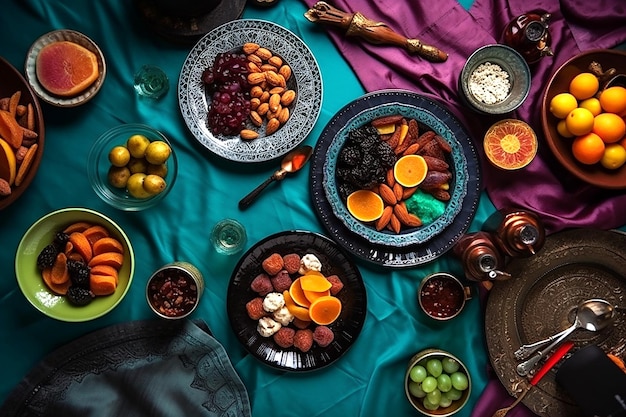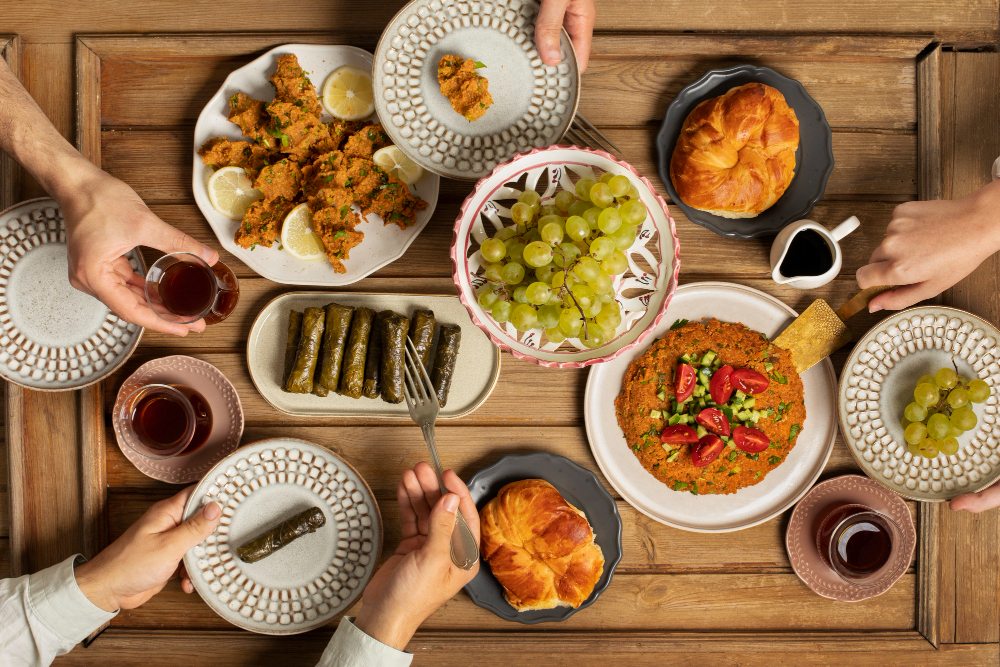Ramadan is a sacred month in the Islamic calendar, observed by Muslims worldwide as a month of fasting, prayer, reflection, and community. It is a time of spiritual growth, self-discipline, and empathy for the less fortunate. One of the most anticipated aspects of Ramadan is the daily breaking of the fast, known as Iftar.
This meal holds immense cultural and social significance, with families and communities coming together to share in the blessings of the season. In this blog post, we will explore the essence of Ramadan, the health benefits associated with fasting, the concept of Iftar, and ten quick and easy Middle Eastern recipes to elevate your Iftar experience.
Table of Contents
What is Ramadan?
Ramadan is the ninth month of the Islamic lunar calendar and is considered the holiest month for Muslims. It commemorates the revelation of the Quran to the Prophet Muhammad and is observed by fasting from dawn to sunset. Fasting during Ramadan is one of the Five Pillars of Islam and is obligatory for all adult Muslims, with exceptions for the elderly, pregnant women, nursing mothers, travelers, and those who are ill.
Health Benefits of Ramadan
Fasting during Ramadan offers a range of health benefits, both physical and spiritual. From a physical standpoint, fasting can help improve insulin sensitivity, promote weight loss, and boost metabolic health. It can also lead to detoxification and cleansing of the body. Spiritually, fasting encourages self-discipline, empathy for the less fortunate, and a sense of community solidarity.
What is Iftar?
Iftar, or the evening meal that breaks the fast, is a significant moment for Muslims during Ramadan. It is a time to gather with family and friends and reflect on the day’s fast. The meal traditionally begins with the consumption of dates and water, following the example of the Prophet Muhammad. Iftar is often a festive occasion, with a variety of dishes served to break the fast.
What is Traditionally Served at Iftar?
Traditional Iftar meals vary across different cultures and regions but often include a combination of fruits, vegetables, grains, and meats. Common dishes include soups, salads, rice dishes, and meat-based entrees. Sweets and desserts are also an essential part of the Iftar spread, symbolizing the sweetness of the blessings of Ramadan.
10 Quick and Easy Iftar Recipes to Make Your Ramadan Special
1. Falafel
Ingredients:
- Chickpeas, soaked overnight
- Onion, chopped
- Garlic, minced
- Fresh parsley, chopped
- Cumin, coriander, salt, and pepper
- Baking powder
- Flour
Instructions:
- Drain and rinse the chickpeas, then add them to a food processor with onion, garlic, parsley, spices, and baking powder.
- Process until smooth, then form into balls and flatten slightly. Dust with flour.
- Fry in hot oil until golden brown and crispy. Serve with tahini sauce.
2. Hummus
Ingredients:
- Chickpeas, drained
- Tahini
- Lemon juice
- Garlic, minced
- Cumin, salt, and pepper
- Olive oil
Instructions:
- Combine chickpeas, tahini, lemon juice, garlic, cumin, salt, and pepper in a food processor.
- Process until smooth, adding olive oil gradually. Adjust seasoning to taste.
3. Tabbouleh
Ingredients:
- Bulgur wheat
- Fresh parsley, chopped
- Fresh mint, chopped
- Tomatoes, diced
- Cucumber, diced
- Red onion, diced
- Lemon juice
- Olive oil, salt, and pepper
Instructions:
- Soak the bulgur wheat in water for 30 minutes, then drain.
- Combine bulgur wheat with parsley, mint, tomatoes, cucumber, and red onion.
- Dress with lemon juice, olive oil, salt, and pepper. Chill before serving.
4. Fattoush Salad
Ingredients:
- Pita bread, toasted and broken into pieces
- Romaine lettuce, chopped
- Tomatoes, diced
- Cucumber, diced
- Red onion, thinly sliced
- Radishes, thinly sliced
- Fresh parsley, chopped
- Sumac
- Lemon juice, olive oil, salt, and pepper
Instructions:
- Combine toasted pita bread, lettuce, tomatoes, cucumber, red onion, radishes, and parsley in a large bowl.
- Sprinkle with sumac. Dress with lemon juice, olive oil, salt, and pepper. Toss to combine.
5. Lentil Soup
Ingredients:
- Lentils, rinsed
- Onion, chopped
- Carrots, diced
- Celery, diced
- Garlic, minced
- Cumin, coriander, turmeric, salt, and pepper
- Vegetable broth
Instructions:
- Saute onion, carrots, celery, and garlic in olive oil until softened.
- Add lentils, spices, and vegetable broth. Bring to a boil, then simmer until lentils are tender. Serve hot.
6. Chicken Shawarma
Ingredients:
- Chicken thighs, boneless and skinless
- Yogurt
- Lemon juice
- Garlic, minced
- Cumin, paprika, turmeric, cinnamon, salt, and pepper
Instructions:
- Marinate chicken thighs in yogurt, lemon juice, garlic, and spices for at least 1 hour.
- Grill or pan-fry chicken until cooked through. Serve with rice or in pita bread with tahini sauce.
7. Lamb Kebabs
Ingredients:
- Lamb, cubed
- Onion, chopped
- Garlic, minced
- Cumin, coriander, paprika, cinnamon, salt, and pepper
- Lemon juice
Instructions:
- Marinate lamb cubes in onion, garlic, spices, and lemon juice for at least 1 hour.
- Skewer lamb and grill or broil until cooked to the desired doneness. Serve with rice and salad.
8. Basbousa
Ingredients:
- Semolina
- Coconut
- Sugar
- Yogurt
- Baking powder
- Butter
- Almonds, blanched
Instructions:
- Combine semolina, coconut, sugar, yogurt, baking powder, and melted butter in a bowl.
- Spread the mixture in a greased baking dish and press blanched almonds on top.
- Bake until golden brown. Pour sugar syrup over the hot basbousa and let it soak. Cut into squares and serve.
9. Knafeh:
Ingredients:
- Shredded phyllo dough
- Ricotta cheese
- Sugar syrup
- Butter, melted
- Pistachios, crushed
Instructions:
Combine shredded phyllo dough with melted butter. Press half of the mixture into a greased baking dish.
Spread ricotta cheese over the dough, then cover with the remaining dough mixture.
Bake until golden brown and crispy. Pour sugar syrup over the hot knafeh and top with crushed pistachios.
10. Date Balls
Ingredients:
- Dates, pitted
- Almonds
- Coconut flakes
- Cocoa powder
Instructions:
- Process dates and almonds in a food processor until finely chopped and combined.
- Roll the mixture into balls, then roll in coconut flakes or cocoa powder to coat.
FAQs
Can I use canned chickpeas for making falafel?
While traditionally falafel is made using soaked chickpeas, you can use canned chickpeas for convenience. Just make sure to drain and rinse them before using.
How long should I soak bulgur wheat for tabbouleh?
Bulgur wheat should be soaked in water for about 30 minutes to soften before using it in tabbouleh.
Can I prepare these recipes in advance for Iftar?
Yes, many of these recipes can be prepared in advance and stored in the refrigerator until ready to serve. This can help save time during the busy month of Ramadan.
Q








I don’t think the title of your article matches the content lol. Just kidding, mainly because I had some doubts after reading the article.
I don’t think the title of your article matches the content lol. Just kidding, mainly because I had some doubts after reading the article.
Thanks for sharing. I read many of your blog posts, cool, your blog is very good.
Your point of view caught my eye and was very interesting. Thanks. I have a question for you.
Howdy! Do you know if they make any plugins to assist with SEO?
I’m trying to get my site to rank for some targeted keywords
but I’m not seeing very good results. If you know of any please share.
Thanks! I saw similar art here: Warm blankets